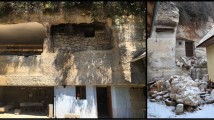Abstract
A procedure for the measurements of the redox capacity of rocks and minerals is presented. Both solid and pulverized samples are used. In a preliminary test described in this paper, an oxygen loss of an aqueous solution in contact with pulverized granodiorite was measured directly on-line, with an oxygen sensor. p]The increase of Fetot in the solution responded relatively well to the oxygen consumption. The maximum rate varied from 3.0 × 10−4 to 9.0 × 10−11 mol l−1 s−1 correspondingly. Oxygen loss of 0.04 mmol (O2) and iron increase of 0.1 mmol were recorded in the solution. Fe(II) reduction in the solid phase was also examined. Fe(II) was inferred to have partially dissolved during the experiment. When the system was equilibrated at the ambient conditions, the vessel was pressurized upto 100 bar with oxygen gas. Three weeks later, the additional decrease of Fe(II) in the solid phase was minimal, only 0.07 % Fe(II) was dissolved or oxidized on the rock surfaces. At this point, the Fetot in the solution, had decreased down to the background level. According to the total oxygen loss at the ambient coditions, the maximum redox capacity of the examined granodiorite (BET 1.0 m2/g) is 0.002 mmol/m2.
Similar content being viewed by others
References
K. R. Applin and Z. Naiyu, The kinetics of Fe(II) oxidation and well screen encrustation, Groundwater 27:2. 168–174 (1989).
C. F. Baes and R. E. Mesmer, The hydrolysis of cations, John Wiley & Sons (1978).
R. A. Baxter, Mechanism of wet oxidation by hydrogen -peroxide. Central Electricity Generating Board, Report TPRD/B/1009/R87, 23 (1987).
C. L. Carnahan, Simulation of effects of redox precipitation on diffusion of uranium solution species in backfill, presented at the 1987 MRS Fall Meeting, Proceeding of Symposium P, 10 (1987).
W. Davison and G. Seed, The kinetics of the oxidation of ferrous iron in synthetic and natural waters. Geo-chim. Cosmochim. Acta 47, 67–79 (1983).
B. M. Dryar, M. T. Naney and S. E. Swanson, Effects of quench methods on Fe3+/Fe2+ ratios A Mössbauer and wet-chemical study, Am. Mineralogist, 72, 792–800 (1987).
T. E. Eriksen, P. Ndalamba, On the formation of a moving redox-front by alpha radiolysis of compacted water saturated bentonite, SKB TR 88–27, 12 (1988).
T. E. Eriksen, P. Ndalamba, H. Christensen and E. Bjergbakke, Radiolyses of groundwater: influence of carbonate and chloride on the hydrogen peroxide production, SKB TR 88–22, 33 (1988).
R. M. Garrels and C. L. Christ, Solutions, minerals, and equilibria, Harper and Row, New York 1965) p. 530.
P. Jamet, Non-dominant, processes; non-equilibrium thermodynamics. Presented at the 6 th Plenary CEC/CHEMVAL Meeting, Madrid, 1989 (unpublished).
C. M. Jantzer and N. E. Bibler, in Scientific Basis for Nuclear Waste Management IX, edited by L.O. Werme (Mater. Res. Soc. Proc. 50, Pittsburg, PA 1986) pp. 219–230.
B. A. Kimball and E. R. Lemon, Air turbulence effects upon soil gas exchange. Soil Sci. Soc. Am. Proc. 35, 16–21 (1971).
T. W. Melnyk and A. M. M. Skeet, An improved technique for determination of rock porosity. Can. J. Earth Sci. 23, 1068–1074 (1986).
I. Neretnieks, in Scientific Basis for Nuclear Waste Management VII, edited by G.L. McVay, (Elsevier Science Publishers, New York, 1984) pp. 1009–1022.
W. G. Nicholson, J. A. Cherry, and E. J. Reardon, Reduction of acid generation in mine tailings through the use of moisture retaining cover layers as oxygen barriers, Can. Geotech. J., 26, 1–8 (1989).
J. F. Penkow and J. J. Morgan, Kinetics for the aqueous environment, Envir. Sci. Tech. 15, 1155–1164 (1981).
V. O. Pirhonen, Measurements of redox capacity of granitic rocks and minerals. Test run and a status of the methods. TVO/KPA, turvallisuus ja tekniikka, työraportti 90-08 (unpublished report), 26 (1990).
V. O. Pirhonen, A. P. Pitkänen, and K. A. Front, Diffusion interfaces of fractures in granitic rocks. Nuclear Waste Commission of Finnish Power Companies, Report YJT-10-90, 20 + app. 22 (1990).
V. O. Pirhonen, K. A. Front, and P. Pitkänen, Porosity and. diffusivity of radionuclides in granitic rocks. Part I: Diffusion interfaces around permeable fractures, presented at the 1990 MRS Fall Meeting, Boston, M.A., 1990, in this issue, (unpublished)
D. W. Shoesmith, S. Sunder, L. H. Johnson, and M. G. Bailey, in Scientific Basis for Nuclear Waste Management X, edited by L.O. Werme (Mater, Res. Soc. Proc. 50. Pittsburg, PA 1986), pp. 309–316.
G. Simmons, and D. Richter, Microcracks in rocks, in Physics and chemistry of minerals and rocks, edited by R. G. J. Strens (John Wiley and Sons, New York 1976), pp. 105–137.
W. Stumm and G. F. Lee, Oxygenation of ferrous iron, Indust. Eng., Chem. 53, 123–143 (1961).
B. Torstenfelt, B. Allard, W. Johnsson and T. Iltner, Iron content and reducing capacity of granites and ben-tonites. SKB TR 83-36, 9 (1983).
F. R. Troeth, J. D. Jabero, and D. Kirkham, Gaseous diffusion equations for porous materials, Geoderma, 27:239–253 (1982).
A. F. White, and A. Yee, Aqueous oxidation-reduction kinetics associated with coupled electron-cation transfer from iron-containing silicates at 25 °C, Geochim. Cosmochim. Acta, 49, 1263–1275 (1985).
A. D. Wilson, The micro-determination of ferrous iron in silicate minerals by a volumetric and a colorimetric method. Analyst 85. 823–827 (1960).
Acknowledgements
The design of the methods was financed by the Ministry of Trade and Industry of Finland (KTM). The experiments were run under a contract for Teollisuuden Voima Oy (TVO). The iron analyzing technique was tested and the analyses were made by Ms. Marja Pitkanen and Mr. Kyösti Isosaari from the Department of Geology and Mineralogy of the University of Helsinki.
Author information
Authors and Affiliations
Rights and permissions
About this article
Cite this article
Pirhonen, V.O., Pitkänen, P., Takala, J. et al. Design and Preliminary Results of Redox Capacity Measurements of Granitic Rocks and Minerals. MRS Online Proceedings Library 212, 839–847 (1990). https://doi.org/10.1557/PROC-212-839
Published:
Issue Date:
DOI: https://doi.org/10.1557/PROC-212-839




